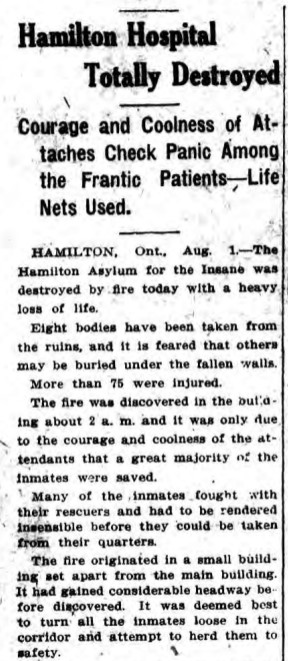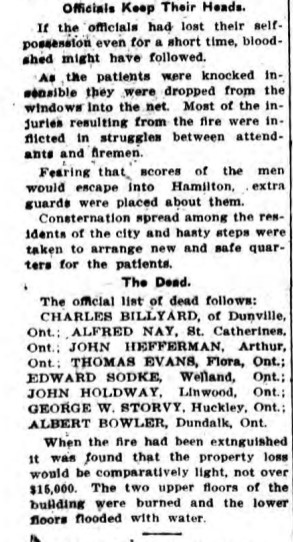As my great-great grandmother, Rosetta Silverstein Fielding, was approaching the end of her first decade confined to the Hamilton Asylum for the Insane, a tragic fire broke out in the the main building of the hospital – the same building where Rose lived.
It was the first day of August 1911, around midnight, when the fire broke out on the fourth floor of the east wing of the Barton building. The following pictures capture the headlines in the Hamilton Herald from August 1, 1911.


This fire became international news when an article about the fire at the Hamilton Asylum was reported in the New York Times on August 2, 1911. The following is a transcription of that article. It provides some tragic details about the fate of these poor men.
“EIGHT MANIACS DIE IN BLAZING ASYLUM”
Building on Hilltop Outside Hamilton, Ont., Catches Fire as Its 800 Inmates Slept
SOME LEAP INTO THE FLAMES
Firemen Struggle with Frenzied Men, Who Are Only Saved by Being Knocked Senseless
“HAMILTON, Ont., Aug. 1 – Eight lives were lost in a fire which partly destroyed one of the main buildings of the insane asylum on the side of the mountain southwest of this city early today. There were 800 sleeping patients in the building when the fire was discovered, and it was only a well-trained fire-fighting corps and coolness and bravery among the nurses and attendants under Dr. English that averted a more serious loss of life.”
“There are four buildings in the group within the asylum grounds. The main building, where the fire occurred, is a four-story brick structure with a basement, 200 feet in length and about 70 feet wide, with wings at either end. The women patients, numbering some 350, occupied quarters in the west wing. The rest of the building was taken up with men’s wards, and contained some of the most desperate cases in the asylum.”
“The women were moved without serious difficulty and housed in the adjoining buildings. The situation among the men was more serious. The fire started on the fourth floor, in what is known as Section D, where the most violently insane are kept. The bulk of the men, guarded by attendants, moved down three flights of stairs out of the fire zone in orderly procession, but about a score, driven into a frenzy by the stifling smoke and the excitement of a midnight fire, fought off their rescuers with desperate fury. Three of them, after being carried down to the second floor, broke away, and fled back into the blazing corridors.”
“The fire in the meantime had spread down the hallway and was eating its way through the floor to the third story. The asylum brigade, although fighting bravely, was handicapped by the maniacs and was losing control.”
“The city brigade, which had been summoned, was then toiling up the almost precipitous roadway leading to the asylum grounds. It was nearly 2 o’clock before the first of their apparatus was brought into play. The firemen ran scaling ladders up to the third and fourth floor windows, where it was believed some of the unfortunates had fled. They found it difficult work to break down the iron grating on the windows, and the fire in the meantime was growing fiercer every minute. Crawling into the stifling smoke, the firemen groped their way about until they found a maniac. If he was unconscious from smoke the task was easy, but if he was still able to offer resistance, he was knocked senseless and dropped into the life nets below. Eights of the insane and one attendant who had lost consciousness in the work of rescue were saved in this way.”
“The combined fire forces had the situation well in hand by 3:30 A.M. The two upper floors and the roof of the east wing were burned and the lower floors were flooded with water. As the firemen worked their way into the burned section some bodies were found. Three were taken out of the hallway on the top floor. It was found that one helpless paralytic was burned to death in his cell. Four more were found huddled together in a small room, burned to a crisp.”
“The blazing roof of the asylum perched up on the mountainside attracted the attention of the entire city. The cry, “The asylum is on fire!” rang through the streets, and hundreds flocked up the hill. It was a weird sight that presented itself. The hysterical screams of the 200 inmates of the four building drowned every other sound. The firemen, fighting both the flames and the maniacs, were in constant peril, and frequently were seen perched on the window sills through which the smoke was pouring in dense columns trying to drag forth a struggling man. One maniac broke from the grasp of a fireman at a window and fled back into the flames, where he perished.”
“A searching investigation has been ordered. The fire is believed to have been caused by a short circuit on an electric wire in the storeroom on the top floor.”

Another account of the fire was reported in the August 1, 1911 edition of the Ithaca Daily News in Ithaca, NY. It offers the names of the men killed in the fire.
“Eight inmates lose lives when canadian insane asylum burns”
“Hamilton Hospital Totally Destroyed”
“Courage and Coolness of Attaches Check Panic Among the Frantic Patients – Life Nets Used”
“HAMILTON, Ont., Aug. 1 – The Hamilton Asylum for the Insane was destroyed by fire today with a heavy loss of life.”
“Eight bodies have been taken from the ruins, and it is feared that others may be buried under the fallen walls.”
“More than 75 were injured.”
“The fire was discovered in the building about 2 a. m. and it was only due to the courage and coolness of the attendants that a great majority of the inmates were saved.”
“Many of the inmates fought with their rescuers and had to be rendered insensible before they could be taken from their quarters.”
“The fire originated in a small building set apart from the main building. It had gained considerable headway before discovered. It was deemed best to turn all the inmates loose in the corridor and attempt to herd them to safety.”
“However, before the inmates could be marshalled in the grounds the flames had mads such headway that the main stairway was cut off. The life nets were then adjusted while the attaches worked to get the men and women to use them. Some of the inmates had to be tossed out like bags of meal. Intense excitement prevailed among the unfortunates who were herded upon the lawn.”
“The institution was set on a high hill and the glare of the fire could be seen for miles.”
“Attaches Tell of Fire”
“Attaches who worked in the rescue work in the upper corridors told exciting stories today of the scenes enacted during the height of the fire. It was not until the exit of the main stairway was cut off that the delirium of terror of the afflicted inmates reached its climax. Men and women who had been tractable for months became violent at the noise and confusion and danger about them.”
“The shouts of the fire-fighters and the roar of the flames aroused them to a panic of frenzy. Only those who maintained some degree of calmness were permitted to leap from the windows, and they were immediately seized as soon as they landed in the life nets. The men, with the superhuman strength of maniacs, attacked attendants and firemen, not only interfering with the work of fighting the flames but threatening to inflict injury upon those who were trying to save them. Many of the attaches were knocked from their feet and trampled upon in the rushes of the insane patients.”
“Officials Keep Their Heads”
“If the officials had lost their self-possession even for a short time, bloodshed might have followed.”
“As the patients were knocked insensible, they were dropped from the windows into the net. Most of the injuries resulting from the fire were inflicted in struggles between attendants and firemen.”
“Fearing that scores of the men would escape into Hamilton, extra guards were place about them.”
“Consternation spread among the residents of the city and hasty steps were taken to arrange new and safe quarters for the patients.”
“The Dead”
“The official list of dead follows: CHARLES BILLYARD of Dunville, Ont., ALFRED NAY, St. Catharines, Ont., JOHN HEFFERMAN, Arthur, Ont., THOMAS EVANS, Flora, Ont., EDWARD SODKE, Welland, Ont., JOHN HOLDWAY, Linwood, Ont., GEORGE W. STORVY, Huckley, Ont., ALBERT BOWLER, Dundalk, Ont.”
“When the fire had been extinguished it was found that the property loss would be comparatively light, not over $16000. The two upper floors of the building were burned and the lower floors flooded with water.”




[…] https://wheresrose.com/2019/07/15/tragedy-at-hamilton-asylum/ […]
LikeLike
[…] https://wheresrose.com/2019/07/15/tragedy-at-hamilton-asylum/ […]
LikeLike